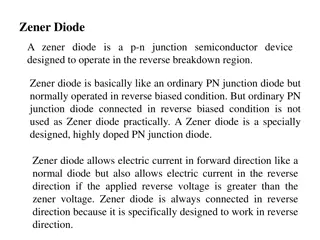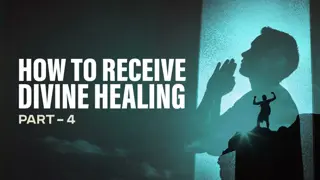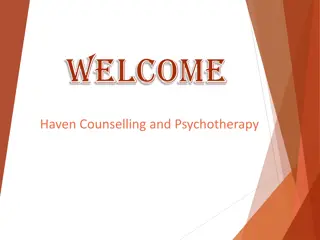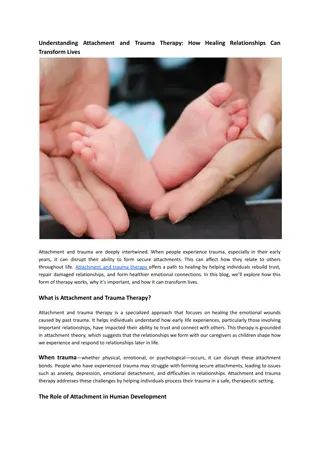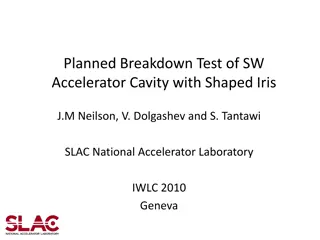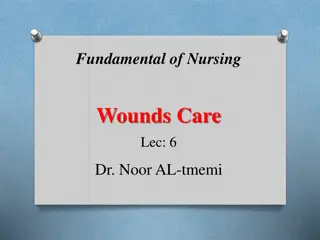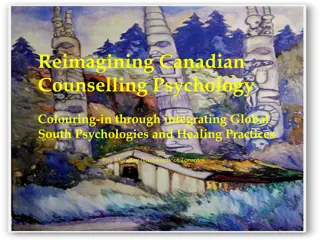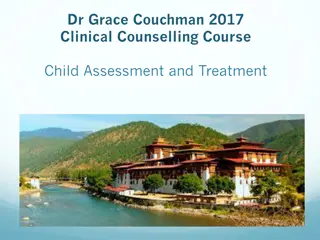
Family Breakdown Counselling: Strategies for Healing and Rebuilding
Family breakdowns can cause emotional turmoil, strained relationships, and lasting pain. Family breakdown counselling offers strategies to heal these wounds and rebuild trust among family members. Through open communication, emotional support, and gu
Download Presentation

Please find below an Image/Link to download the presentation.
The content on the website is provided AS IS for your information and personal use only. It may not be sold, licensed, or shared on other websites without obtaining consent from the author. Download presentation by click this link. If you encounter any issues during the download, it is possible that the publisher has removed the file from their server.
E N D
Presentation Transcript
Understanding Attachment and Trauma Therapy: How Healing Relationships Can Transform Lives Attachment and trauma are deeply intertwined. When people experience trauma, especially in their early years, it can disrupt their ability to form secure attachments. This can affect how they relate to others throughout life. Attachment and trauma therapy offers a path to healing by helping individuals rebuild trust, repair damaged relationships, and form healthier emotional connections. In this blog, we ll explore how this form of therapy works, why it s important, and how it can transform lives. What is Attachment and Trauma Therapy? Attachment and trauma therapy is a specialized approach that focuses on healing the emotional wounds caused by past trauma. It helps individuals understand how early life experiences, particularly those involving important relationships, have impacted their ability to trust and connect with others. This therapy is grounded in attachment theory, which suggests that the relationships we form with our caregivers as children shape how we experience and respond to relationships later in life. When trauma whether physical, emotional, or psychological occurs, it can disrupt these attachment bonds. People who have experienced trauma may struggle with forming secure attachments, leading to issues such as anxiety, depression, emotional detachment, and difficulties in relationships. Attachment and trauma therapy addresses these challenges by helping individuals process their trauma in a safe, therapeutic setting. The Role of Attachment in Human Development
To understand how attachment and trauma therapy works, its important to first understand attachment itself. Attachment refers to the emotional bond that forms between a child and their primary caregiver, usually a parent. This bond is crucial for healthy emotional and social development. When children feel safe and nurtured, they develop a sense of security that allows them to explore the world, build relationships, and handle challenges. However, if a caregiver is inconsistent, neglectful, or abusive, it can lead to what is known as insecure attachment. This can cause children to grow up feeling unsafe, unworthy of love, and unable to trust others. These feelings often carry into adulthood, affecting how individuals interact with partners, friends, and even their own children. How Trauma Affects Attachment Trauma, especially in early childhood, can significantly disrupt attachment. Whether it s due to abuse, neglect, loss of a parent, or witnessing violence, traumatic experiences can cause individuals to feel unsafe and unprotected. This can lead to emotional difficulties, such as fear, anger, or withdrawal. As a result, people may struggle to form healthy, trusting relationships in their adult lives. For example, someone who experienced abandonment as a child may have difficulty trusting their romantic partners. They might fear that they will be left again, leading to anxiety, insecurity, or unhealthy behaviors in their relationships. How Attachment and Trauma Therapy Works Attachment and trauma therapy aims to help individuals heal from these early wounds by fostering safe and supportive therapeutic relationships. Through this process, individuals can rebuild their capacity for trust and emotional connection. Here s how the therapy typically works: 1. Creating a Safe Space: The therapist provides a secure and non-judgmental environment where the individual feels safe to express their feelings and experiences. This is essential for the healing process, as many trauma survivors may have difficulty opening up about their pain. 2. Exploring Past Relationships: The therapist helps the individual explore their early relationships, especially with caregivers, to understand how these experiences have shaped their attachment style. By reflecting on these relationships, the person can begin to recognize patterns in their current relationships and emotions. 3. Processing Trauma: Trauma therapy involves processing painful memories and emotions in a controlled, therapeutic manner. This might involve techniques such as cognitive-behavioral therapy (CBT), somatic therapy, or eye movement desensitization and reprocessing (EMDR). The goal is to reduce the emotional impact of traumatic memories. 4. Building New Attachment Patterns: As the individual works through their trauma, the therapist helps them develop healthier ways of relating to others. This may involve learning new coping strategies, practicing emotional regulation, and building trust in relationships. The Benefits of Attachment and Trauma Therapy Attachment and trauma therapy offers many benefits for those who have experienced emotional wounds. Some of the most significant benefits include:
Improved Relationships: By addressing the root causes of insecure attachment, individuals can develop healthier, more fulfilling relationships with partners, friends, and family members. Reduced Anxiety and Depression: Healing from trauma can help reduce symptoms of anxiety and depression, which are often linked to unresolved emotional pain. Increased Emotional Resilience: Therapy helps individuals build emotional resilience, allowing them to better cope with life s challenges. Enhanced Self-Esteem: As individuals heal from their trauma and learn to form secure attachments, they often experience improved self-esteem and a greater sense of self-worth. Conclusion Attachment and trauma therapy is a powerful tool for healing the emotional wounds caused by early trauma. By helping individuals rebuild trust and repair their attachment patterns, this therapy can lead to profound changes in how they relate to others and experience the world. If you or someone you love is struggling with the effects of trauma, seeking the support of a trained therapist can be the first step toward healing and transformation.


